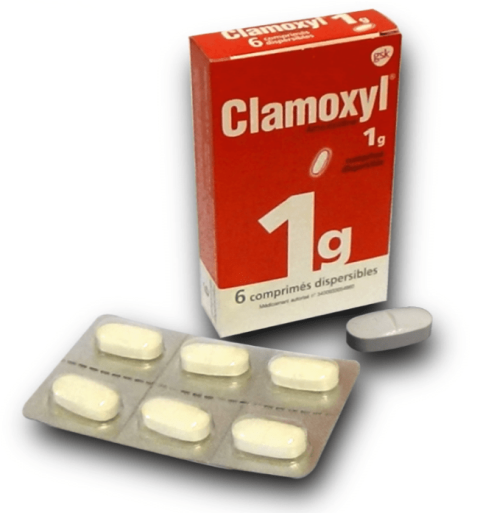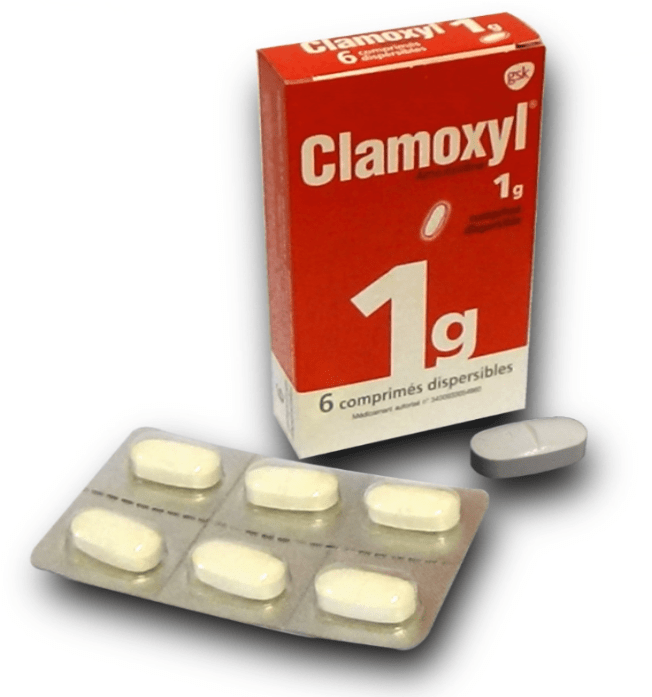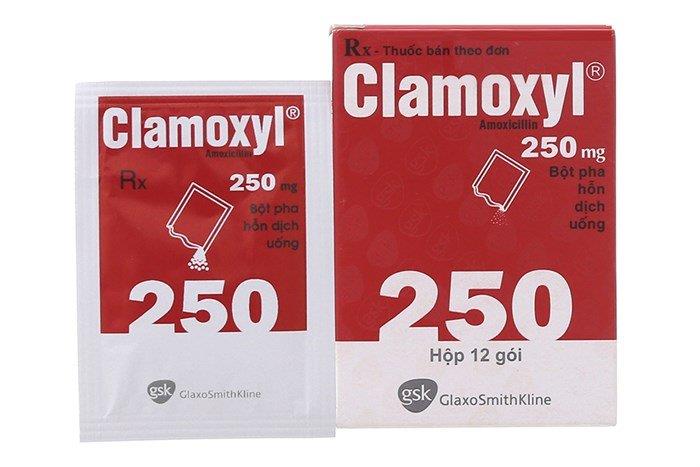What you need to know about the antibiotic Clamoxyl (amoxycillin)

What is Clamoxyl (amoxycillin)? How to use the drug to achieve the effect? What should be kept in mind when taking the drug? Let's analyze the article with SignsSymptomsList below to understand more about Clamoxyl (amoxycillin)!
Active ingredient: amoxycillin.
Similar ingredient names: Amomid; Amoxclo; Amoxfap; Amoxico-500;
Amoxipen; Lupimox; Lykamox; Mekomoxin; Midamox; Mocecil; Moxacin; Moxilen;…
content
- 1. What is Clamoxyl (amoxycillin)?
- 2. Indications for Clamoxyl (amoxycillin)
- 3. Instructions for taking Clamoxyl (amoxycillin)
- 4. Clamoxyl (amoxycillin) side effects
- 5. Drug interactions with Clamoxyl (amoxycillin)
- 6. Note when taking Clamoxyl (amoxycillin)
- 7. For pregnant and lactating women
- 8. Treatment of Clamoxyl overdose
- 9. What to do when you forget a dose of Clamoxyl
- 10. How to store medicine
1. What is Clamoxyl (amoxycillin)?
Clamoxyl is a brand name drug that contains amoxycillin. Amoxycillin is a beta-lactam antibiotic. The drug works by inhibiting bacterial cell wall synthesis. Therefore, amoxycillin has bactericidal ability.
2. Indications for Clamoxyl (amoxycillin)

- Upper respiratory tract infections, sinusitis, otitis media.
- Lower respiratory tract infections caused by streptococci, pneumococci, non-penicillinase-producing staphylococci and H. influenzae.
- Uncomplicated urinary tract infections; biliary tract infections; skin infection.
- Gonorrhea, anthrax, Chlamydia trachomatis infection of the urogenital tract in pregnant women
- Lyme disease in children or pregnant or lactating women.
- Gastroenteritis, endocarditis, typhoid fever and paratyphoid fever.
- Combination with other drugs in the treatment of H. pylori infection in patients with peptic ulcer.
Calmoxyl should not be used if you are allergic to the antibiotic amoxycillin or to any of its other ingredients.
3. Instructions for taking Clamoxyl (amoxycillin)
3.1. How to use
- For oral use only, amoxicillin sodium salt for injection only.
- Can be taken before or after a meal because it does not affect the absorption of the drug.
- Powder for suspension when used can be mixed with milk, juice, water and drink immediately after mixing.
3.2. Amount
3.2.1. Sensitive bacterial infections of the ear, nose, throat, skin, urinary tract
Adult
- Mild, moderate: 250 mg every 8 hours or 500 mg every 12 hours.
- Severe infections: 500 mg every 8 hours or 875 mg every 12 hours.
Children
From mild to moderate:
+ 20 mg/kg/day every 8 hours.
+ Or 25 mg/kg/day every 12 hours.
Severe infections:
+ 40 mg/kg/day every 8 hours.
+ Or 45 mg/kg/day every 8 hours.
3.2.2. Helicobacter pylori infection

Adult
- 1 g x 2 times/day, in combination with clarithromycin 500 mg x 2 times/day and omeprazole 20 mg x 2 times/day (or lansoprazole 30 mg x 2 times/day) x 7 days.
- Then, take 20 mg of omeprazole (or 30 mg of lansoprazole) daily for another 3 weeks if duodenal ulcer is advanced, or 3 to 5 weeks if peptic ulcer is advanced.
3.2.3. Prophylaxis of infective endocarditis
Adult
- A single dose of 2 g, taken 1 hour before the procedure.
Children
- A single dose of 50 mg/kg (do not exceed the adult dose)
- Drink 1 hour before the procedure.
3.2.4. Lyme disease
Mild heart inflammation (1st or 2nd degree atrioventricular block):
- Adults: 500 mg x 3 times/day x 14 - 21 days.
- Children < 8=""> 50 mg/kg/day in 3 divided doses (maximum dose of 1.5 g/day).
Arthritis, without Lyme disease neurological disorder:
- Adults: 500 mg/time, 3 times/day for 28 days.
- Children: 50 mg/kg/day in 3 divided doses (maximum dose of 1.5 g/day).
The above dosage is for reference only. Please consult your doctor before use.
4. Clamoxyl (amoxycillin) side effects
- Slight increase in liver enzymes
- Erythema, hives
- Appearance of rash (usually after 7 days of treatment)
- Associated with blood disorders (leukopenia)
- Agitation, restlessness, anxiety, insomnia, confusion, changes in behavior and/or dizziness
- Nausea, vomiting, epigastric pain, diarrhea in adults (more common in children and the elderly).
- Clostridium difficile pseudomembranous colitis; acute pyelonephritis with abdominal pain and bloody stools, unrelated to C. difficile.
5. Drug interactions with Clamoxyl (amoxycillin)
- Warfarin
- Nifedipine
- Allopurinol
- Probenecid
- Methotrexate
- Typhoid vaccine
- Oral contraceptive pills
- Fusidic acid, chloramphenicol, tetracycline
6. Note when taking Clamoxyl (amoxycillin)
- The drug may cause crystallization and less urination
- There is a high risk of rash in patients with infectious mononucleosis.
- Check hematological indexes, liver and kidney function periodically during long-term treatment with the drug.
- Serious hypersensitivity reactions may occur in patients who have been allergic to amoxycillin.
- Use high doses of Atarax for people with kidney failure or people who have ever had seizures, epilepsy can cause convulsions (rarely). Therefore, it is necessary to adjust the dose accordingly.
7. For pregnant and lactating women
7.1. Pregnant women
There is not enough evidence to show the safety of this drug in this subject. At the same time, there is no evidence of harmful effects on the fetus when amoxicillin is administered to pregnant women.
Amoxycilin is the drug of choice for the treatment of Chlamydia infection and for the treatment of cutaneous anthrax or as a precaution following exposure to Bacillus anthracis spores in pregnant women.
7.2. Breastfeeding Women
Amoxicillin is excreted in breast milk, however, in very small amounts in breast milk and is safe for infants at commonly used doses.
Because the drug is safe, amoxicillin can be used in breastfeeding women. However, careful monitoring is required.
8. Treatment of Clamoxyl overdose
Symptoms may include:
- Neuropsychiatric.
- Kidneys (crystal urine)
- Digestive disorders.
There is currently no specific antidote. However, amoxicillin can be removed by hemodialysis. You need to treat symptoms, especially pay attention to the water-electrolyte balance because the drug can cause diarrhea when taken.
9. What to do when you forget a dose of Clamoxyl
- Use as soon as you remember that you have missed a dose.
- If it is almost time for the next dose, skip the missed dose and take it on schedule.
- Never take a double dose to make up for a missed dose.
10. How to store medicine
- The best drug storage temperature is ≤25 ºC.
- Keep medicine out of reach of children and young children
- Do not leave the medicine in a place exposed to direct light or in a humid place
- Do not use expired medicine. Disposal of unused medicine should be handled carefully before being released into the environment
Clamoxyl (amoxycillin) is used to treat bacterial infections. Because this is an antibiotic, the patient may experience side effects such as diarrhea, rash... Always monitor yourself, if you have any unusual symptoms, call your doctor immediately for assistance in handling. Please!
Pharmacist Nguyen Ngoc Cam Tien